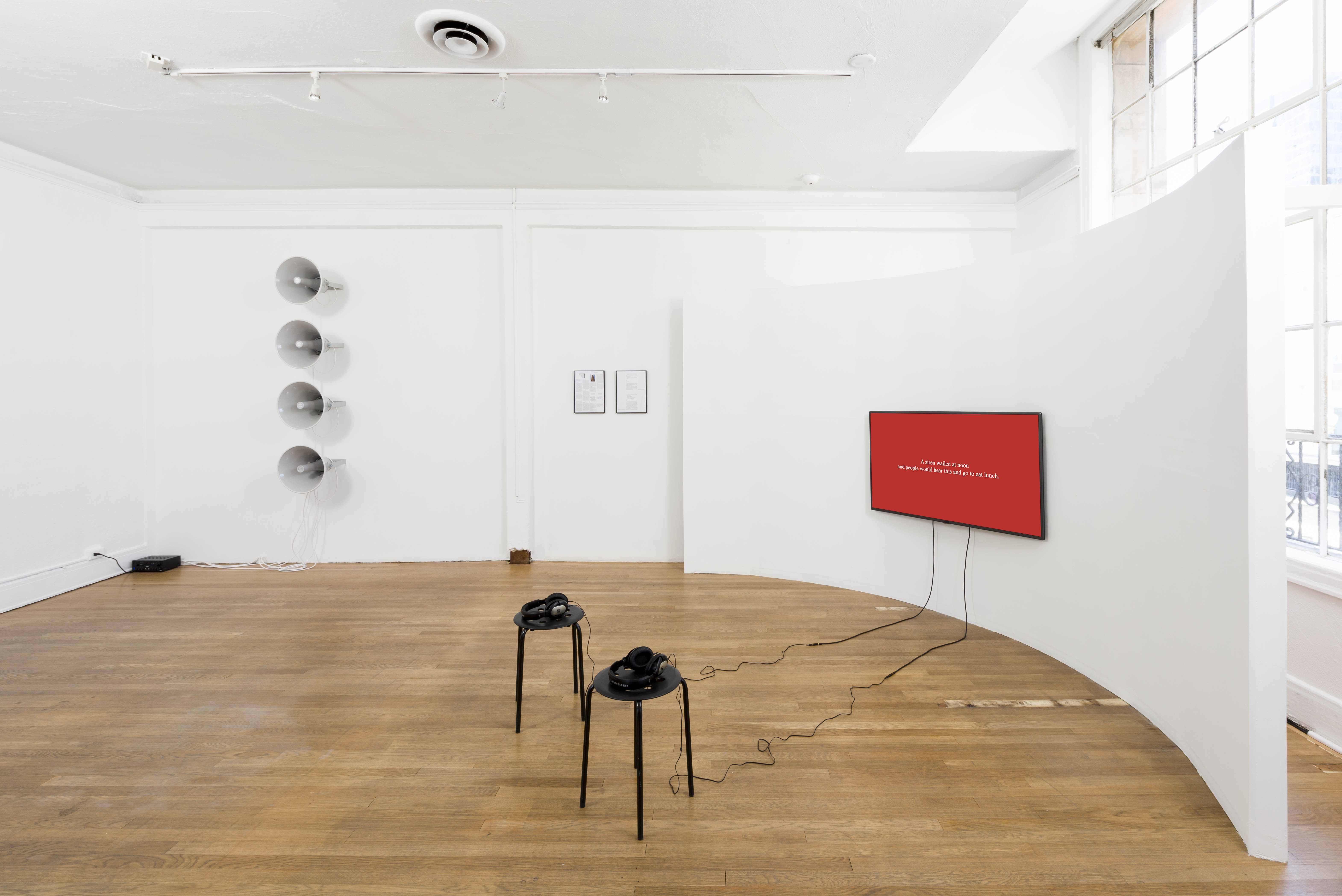Red Noise Visit
2018
Single-channel video, stereo & binaural sound
12 minutes 6 seconds Dimensions variable
This work spotlights two contrasting sounds that existed during the modernization of Korea. The first of these sounds is the siren, remembered in particular contexts as the “noon siren” and the “curfew siren.” Sirens effectively synchronized daytime laborers’ daily routines and maintained control over their evenings across successive historical periods, from the Japanese colonial period to the U.S. military government era, and the wartime up to the age of dictatorship. Over the course of 36 years, the curfew siren, in particular, gradually instilled within the nation a strict temporal discipline, dominating the space, time, and minds of individuals. In Osu-myeon, Imsil-gun, Jeollabuk-do, Korea, stands the tallest red-brick watchtower in existence, built during the Japanese occupation to surveil residents. After Korea’s liberation, it began to function as a siren tower. The story within this work begins with the echoic memory of local residents, recalling the siren in tandem with the rigid visuality of the red brick tower and gradually expands to the story of the curfew siren.
The other sound was that of the radio. It produced sounds that gathered hidden listeners within the darkness that fell after the curfew siren. It was, at times, deliberate propaganda directed between the South and the North, and at other times, a regular broadcast signal that unintentionally crossed past borders. In an age of strong anti-communism, it was illegal to listen to something like the radio, which blurred spatial boundaries. Therefore, listening to the radio was always a secret, personal experience. The story within this work is about the memory of someone who was involved in espionage activities in the late 1960s and would listen to the broadcasts from the South while in the North. At that time, the perceived sound of all radio signals was labeled by a press as “Red Noise.”
Two vexed sounds—two “red noises”—one oppressively striking down upon the flow of time, the other permeating across spatial borders. What traces did the siren leave on individual lives after acts of forced collective listening and temporal suppression? On the other hand, how did radio galvanize the rebellious imaginations of secluded listeners?
To get closer to these sounds of the past, which are realistically well out of reach, I researched news articles, interviews, and essays describing the sonic memories of the siren and radio. I then arranged excerpted text from the sources into the video; the text moves through various speakers and spatiotemporal dimensions. Using electroacoustic techniques, recorded voice and found objects, recomposed siren and radio sounds are juxtaposed with the video.
Commissioned by the Arko Art Center in 2018
(KR)
*This video features binaural audio recordings. For the best listening experience, listen with headphones.
2018
Single-channel video, stereo & binaural sound
12 minutes 6 seconds Dimensions variable
This work spotlights two contrasting sounds that existed during the modernization of Korea. The first of these sounds is the siren, remembered in particular contexts as the “noon siren” and the “curfew siren.” Sirens effectively synchronized daytime laborers’ daily routines and maintained control over their evenings across successive historical periods, from the Japanese colonial period to the U.S. military government era, and the wartime up to the age of dictatorship. Over the course of 36 years, the curfew siren, in particular, gradually instilled within the nation a strict temporal discipline, dominating the space, time, and minds of individuals. In Osu-myeon, Imsil-gun, Jeollabuk-do, Korea, stands the tallest red-brick watchtower in existence, built during the Japanese occupation to surveil residents. After Korea’s liberation, it began to function as a siren tower. The story within this work begins with the echoic memory of local residents, recalling the siren in tandem with the rigid visuality of the red brick tower and gradually expands to the story of the curfew siren.
The other sound was that of the radio. It produced sounds that gathered hidden listeners within the darkness that fell after the curfew siren. It was, at times, deliberate propaganda directed between the South and the North, and at other times, a regular broadcast signal that unintentionally crossed past borders. In an age of strong anti-communism, it was illegal to listen to something like the radio, which blurred spatial boundaries. Therefore, listening to the radio was always a secret, personal experience. The story within this work is about the memory of someone who was involved in espionage activities in the late 1960s and would listen to the broadcasts from the South while in the North. At that time, the perceived sound of all radio signals was labeled by a press as “Red Noise.”
Two vexed sounds—two “red noises”—one oppressively striking down upon the flow of time, the other permeating across spatial borders. What traces did the siren leave on individual lives after acts of forced collective listening and temporal suppression? On the other hand, how did radio galvanize the rebellious imaginations of secluded listeners?
To get closer to these sounds of the past, which are realistically well out of reach, I researched news articles, interviews, and essays describing the sonic memories of the siren and radio. I then arranged excerpted text from the sources into the video; the text moves through various speakers and spatiotemporal dimensions. Using electroacoustic techniques, recorded voice and found objects, recomposed siren and radio sounds are juxtaposed with the video.
Commissioned by the Arko Art Center in 2018
(KR)
*This video features binaural audio recordings. For the best listening experience, listen with headphones.









#1-2
Exhibition view of Korea Artist Prize (National Museum of Modern and Contemporary of Art, Korea, Seoul, 2025). Image courtesy of National Museum of Modern and Contemporary Art, Korea. Photo: Chulki Hong.
#3-6
Exhibition view of Bones of Sound (Visitor Welcome Center, Los Angeles, 2019). Photo: Ruben Diaz.
#7-9
Exhibition view of Unclosed Bricks: Crevis of Memory (Arko Art Center, Seoul, 2018). Photo: Kyung Roh.
1 min video excerpt